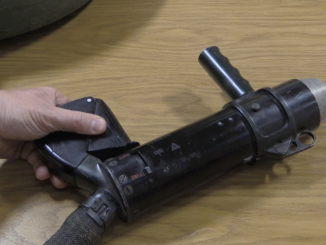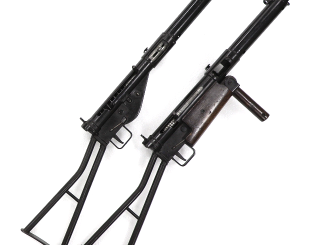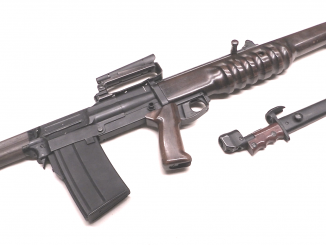In 1907, the British adopted the final major pattern in the evolution of the Short, Magazine, Lee Enfield. Designated the ShtLE MkIII (Short Lee Enfield) at the time, it would be retroactively renamed Rifle No1 MkIII in the 1920s. This new design was simpler and more durable than its predecessors while actually improving the practical accuracy of the rifle. The rear sight protector wings were substantially strengthened, the front sight became a square post, the front sight protectors were opened up to allow more light in, and the rear sight windage adjustment was simplified – while retailing 1 MOA adjustment clicks and 25m elevation adjustments. A new bayonet was also adopted in 1907 for the MkIII. The previous 1903 pattern bayonet was deemed too short, and the British essentially copied the Japanese Type 30 Arisaka bayonet as its new Pattern 1907 – hooked quillion and all.
The example we are looking at in today’s video is a fantastic specimen, as it was sold out of service to an Australian reservist in 1912 having not received any post-production modifications or updates. It is still sighted for the early MkVI round-nose ammunition, for example, and its bayonet retains the hooked quillion. The rifle’s owner died prior to World War One, and the gun remained stored away and forgotten through both World Wars, where virtually all existing service rifles were taken back into service and updated. Only in the 1960s was this one found, making it a pristine collector’s example to show how the MkIII was originally produced.




Very nice example indeed. The owner must be very pleased with it to say the least.
Good video of a rifle with a cool story.
The “volley fire” early feature has always interested me (unlike the magazine cutoff!). I would like to see a platoon of rifleman shooting at a target at 3000m…
I suspect that a volley must be done “on command,” not “at will.” Getting everyone to synch up is NOT going to be easy, and it’s even less easy if anyone is twitchy. I could be wrong.
Volley fire was something that armies practiced quite regularly in the single shot musket/rifle era. With smooth bore muskets the ranges of volley fire were naturally not nearly as great as with rifles, but the principles were the same. Soldiers were trained to take aim and fire their weapons on command.
The advent of repeating rifles and smokeless high velocity cartridges didn’t change the principles of a volley fire drill that much, although now the officer (sometimes an NCO) always had to provide the range as well as direction of fire, if and when long range volley fire was to be used. At the same time shorter range volley fire (with the main sights of the rifle) became less used, although the exact time of its removal from doctrine varied greatly from country to country.
The separate long range sights of late 19th and early 20th century infantry rifles are called volley fire sights, because by the time they were common, volley fire was primarily used at long ranges only. Or rather I should perhaps say it was envisaged to be used at long ranges. In practice long range volley fire beyond the maximum range of the primary sights seems to have been quite rare. I don’t know if anyone has done research on this specific matter. It would certainly be interesting to know more exactly where and how the volley sights were used in practice.
That was the whole point of volley fire. It was done “on command” and “by the numbers”. The purpose was to create a “beaten zone” at the range set on the VF sights.
The German Army had a simpler way of doing it that the British Army later adopted. It was called the Maxim machine gun. Which is interesting in view of the Maxim being British to begin with.
But it was the Germans who first recognized that the heavy machine gun could effectively be used as a mass-fire, indirect-fire interdiction weapon, in addition to a direct-fire support weapon. Thereby essentially superseding rifle volley fire at extreme ranges in most cases. Why detail off an entire infantry section to do something that a single three-man HMG team could do much more quickly and efficiently?
Of course, the British version generally involved an entire HMG section (five gun teams) or even two or three at once. A case of “There is no ‘overkill.’ There is only ‘open fire’ and ‘reload’.” (Schlock Mercenary; The Seventy Rules of Maximally Effective Mercenaries, Rule #37.)
cheers
eon
“Which is interesting in view of the Maxim being British to begin with.”(C)
Gringo, actually.
https://en.wikipedia.org/wiki/Hiram_Maxim
Salvo fire originates from the tactics of repelling a cavalry attack.
After the first shot, the remaining arrows in the chain stopped seeing the target due to the smoke. Therefore, everyone fired at the same time.
In addition, statistically, a simultaneous swarm of projectiles is more likely to hit the target than the same alternate shots.
This was later used to fire a group of soldiers at another group.
Or another goal, big enough for the theory of probability to start working.
Given Tommy’s penchant for irreverent punning nicknames, I guess it’s lucky the SMLE / ShtLE became Old Smelly instead of Old Shitley.
It possibly did.
There seems to be a propaganda technique of using something that is obviously derogatory to pre-empt or bury something that sets people thinking.
For example, The British Queen’s husband…
Even some of the newspapers refer to him as “Phil the Greek”, and yes, he is a member of the Greek (formerly) royal family.
But, was that derogatory, perhaps to distract attention away from his (hers and every other European royal’s) German ancestry?
As far as rifles go, the No1 Mkiii and the Numbers 4 and 5, are such good rifles that their reputation could easily have withstood being called sh*t Lees.
The FAL, too.
The British state demonstrated its sensitivity about the cluster f##k that is the SA80, when they closed down Jan Stevenson’s “Handgunner” magazine, for publishing the dirt about just how amazingly bad the guns were.
Like state bureaucrats throughout history, they acted as though silencing the truth by iintimidatinga writer, would somehow change the reality.
It still goes on, cough_assange_coughcoughcough 😐
Yes indeed. Trying to repress unpleasant truths only kicks the mockery into high gear!
It is amazing how a nation with such a fine tradition of riflery managed something like the SA80. I wonder how many history-minded soldiers have found themselves wishing for SMLEs.
Keith:
I had thought that the demise of the much missed “Handgunner” as well as “Guns Review” was due to the large drop in advertising revenue following the handgun ban in 1997.
I would have thought that “Guns Review” at least could have kept going, but it was not to be. There are still various shooting magazines, after all. But obviously, the government enforced demise of pistol shooting also put an end to the businesses which had advertised in “Handgunner”.
One day, maybe, we will get the government we deserve. Until then…
Get a copy of Pre WWII film HG WELLS SHAPE OF THINGS TO COME. Lots of Smelly on screen.
I doubt the original owner would have been doing any sort of obligatory military service. That was not a thing in the British Empire before WWI. All soldiers were volunteers. The owner would most likely have been in the Australian version of the Territorial Army, which might explain why he was allowed to buy his rifle when he left.
As to the story that his family “forgot” about the rifle in WWI and WWII, again, I find that doubtful. The Australian government tried to round up privately held rifles in both wars, and it was not popular at all. I imagine the view of the family was that it was their property, and they did not want to lose it to the government. Good for them I say. If governments want guns, just buy them like anyone else.
I must say the SMLE had beautiful sights. Ideal for the range, but I am sure the rifles shot far better than 99% of the troops who used them.
Au contraire, Australia had conscription starting just before this rifle was made.
Staghounds:
You are right, a limited form of conscription for some 18 to 20 year olds was introduced in Australia in 1909. Whether a conscript would have been allowed to buy his rifle I don’t know, but I would suspect this SMLE would have been owned by a volunteer.
One cool thing you overlooked on the markings under the bolt. ER with the Crown for EDWARD REGINA. All the SMLEs I’ve ever seen have had GR for George -as on the No.1 mk III I bought in 1964.
John:
That would be “Edwardus Rex”, but I agree with you, it is interesting to see a rifle marked for Edward VII, which must be a very small subset of the millions of SMLEs which were built in the reign of George V.
Eduardus Rex
🙂
Turpin,
Good point, the Romans did not have a letter “w”. Mind you, they did not have a letter “u” either, so that would most properly read “Edvardvs Rex”.
…I think given names – if a need arises – are transcribed in post-classical Latin; technically, medieval spelling is used. “U” will do, perhaps even occasional “J”.
Vide infra:
https://la.wikipedia.org/wiki/Eduardus_VII_(rex_Britanniarum)
…sed disputatio nostra de bellis igniferis debet esse 🙂
Turpin:
If you look at the inscription on Admiralty Arch, it says:
ANNO DECIMO EDWARDI SEPTIMI (the tenth year of Edward VII)
So clearly “Edwardus” with a “w” was acceptable during the late king’s lifetime. I must admit I could not recall seeing his name given as “Eduardus”.
“..I wanted to be a judge but I didn’t have the Latin for it…” Thanks for the correction. Pity the British discontinued such markings…think how neat a No4 mk2
marked E*R would be.
John,
That’s a good point. I think production of the No4 rifle continued into the early years of the Queen’s reign, but I am not sure what the marking conventions were by then. Likewise, Australia continued making SMLEs well into the 1950s.
I’ve read that at the battle of Omdurman, the volley sights were indeed used. A massed enemy was brought under fire at something over a mile range. With an effect that should have demonstrated the futility of their later charging.
My Pattern 1907 bayonet has been to the wars, and the ricasso markings are a bit hard to read. The royal cipher is partly obscured by a large, deep “1907,” which I had taken to be a model designation. If it’s the actual date of manufacture, then I’ve got an Edwardus Rex relic! The sword-breaker hook is missing, and if an armorer removed it, he did a nicely finished job. Surprisingly, the blade seems at some time to have been sharpened.
The most evocative marking is on the right grip panel: a soldier’s rudely carved M or W. This bayonet once belonged to either Mike or Wully. Wish I could treat one or both to a pint.
A very interesting plot.
Merci.
hey great video please start a rumble or bitchute page
Hi Ian,
The SMLE MkIII* equipped all the Bns of the Royal Australian Reg’t throughout The Korean War. And the (also Lithgow made) SMLE IIITs – with a WWI design telescope and a heavy barrel for selected Mk7 ammo were still in use for training marksmen in 1976. I’ve fired a LOT of .303 cases through SMLEs and sporterised .303/25s and I’ve never, ever had a rim-jam. The rim-jam issue just isn’t.
The SLR L1A1 (FAL) did not enter service until the late 1950s.
Would love a response to this post AND the one to MAE about manipulating the SMLE III’s bolt action. OR a video where she gets it right.
regards
Tim Bailey
Tim:
The Lee Enfield bolt is probably the best one of any military rifle, no doubt about that. It falls just right under the hand, and I am particularly pleased that the British never went for a straight bolt handle, it took most nations decades to work that one out, and some never did.
I believe that the Diggers at Gallipoli achieved very rapid fire from their SMLEs by working the bolt with thumb and the first two fingers, firing with the third finger. Try that with a Lebel or a Mosin-Nagant.
I would like to know why India and Australia kept with the SMLE when Britain and Canada adopted the No4. The latter was designed to be easier to manufacture, and I feel that the rear aperture sight behind the bolt is much easier to use than the “u” notch sight in front of the bolt.